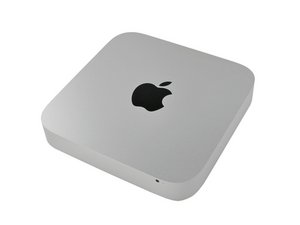Should I replace the thermal paste on my mini?
Hi:
My mini is still under warranty as it hasn't been out for very long. This is actually my 2nd mini as I exchanged the first one hoping the 2nd one would run cooler. But they run almost identical. This mini has the discrete gpu thus ~6W idle additional heat to dissipate.
I am irritated that I cannot enjoyably stream Netflix without the cpu die reporting 95C via iStat Menus and Hardware Monitor by Bresink, although it does settle out to ~90C. This i5's thermal limit is 100C. Thankfully the SMC is working as the fan runs at almost full and thus I can hardly even hear the movie. Now I know that the total amount of heat isn't going to change by reapplying thermal compound but I think it might greatly reduce the die temp and thus allow the fan to back off a bit.
The mini is on a metal wire shelf that allows airflow into the bottom intake and the rear cables come down from the top so as to not obstruct the exhaust vent. The room is at 26C (55%RH) and the mini idles (2% cpu) at 71C cpu diode and about 66C cpu proximity with ambient air sensor in mini at 56C.
I recently had Apple fix my MBP6,1 17" as it was also having thermal problems however it took almost a week of *arguing* with Apple to get them to make it right, but now it idles at 42C and never goes over like 86C and it used to hit like 103C. I know the mini won't be that cool but I want to know if it can do better than my current readings? I woud assume do this fix myself as the arguing with Apple is incredibly stressful. Oddly none of the reviewers seemed to mention temperature data? I would be curious to see a picture of the cpu die before you cleaned it off in your tear down if you have it? Oh and if these temps are like clearly showing a problem with my mini to the extent that Apple might listen then please tell me :)
Thanks for any advice / stats you can give. I admit I am a tad scared to tear the mini apart but the needing to know what the temp *could* be is killing me :D
Ryan
[update - AUG 29]
A friend of mine bought a new mac mini (base model) and it runs just as hot. Yet he found a mac mini in an Apple Store didn't run hot. Perhaps some cool units exist? I found that Netflix is just bearable with Plex as it uses slightly less cpu than chrome or safari. Probably will endup getting a ROKU or an Apple TV for the future as the mini just sucks at Netflix. Anyways last night I decided to point a fan at my mini. This drops the idle temp from 70C to ~60C (internal fan chills out too). Kinda annoying having the extra fan noise but helps a lot and makes the top of the mini touchable. So that is my temporary advice. I may try water cooling the top of the mini in the future just to avoid the extra fan noise.
As for repasting I will indeed hold off as that seems like the wise thing to do. Also it seems that the GPU either has hardware problems or is in serious need of better drivers. As youtube videos will get like weird green stuff going on and windows with transparency on my other monitor will get weird crosshatch patterns (concurrent). Thus I want to wait and see if Apple is gonna software update or if this unit has issues. Once all that is sorted out and my warranty is nearing the end I will reapply z paste.
[pictures of mini w/ fan xD]
http://dl.dropbox.com/u/2091843/ifixit/m...
http://dl.dropbox.com/u/2091843/ifixit/m...
Is dit een goede vraag?


 3
3  1
1 
 1
1 
